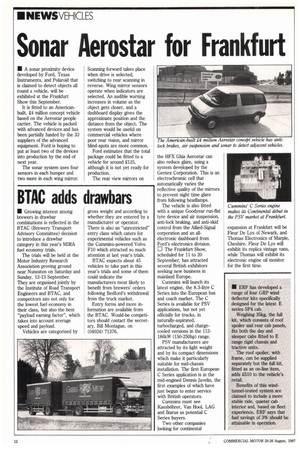Sonar Aerostar for Frankfurt
Page 14

If you've noticed an error in this article please click here to report it so we can fix it.
• A sonar proximity device developed by Ford, Texas Instruments, and Polaroid that is claimed to detect objects all round a vehicle, will be exhibited at the Frankfurt Show this September.
It is fitted to an Americanbuilt, £4 million concept vehicle based on the Aerostar people carrier. The vehicle is packed with advanced devices and has been partially funded by the 33 suppliers of the advanced equipment. Ford is hoping to put at least two of the devices into production by the end of next year.
The sonar system uses four sensors in each bumper and two more in each wing mirror. Scanning forward takes place when drive is selected, switching to rear scanning in reverse. Wing mirror sensors operate when indicators are selected. An audible warning increases in volume as the object gets closer, and a dashboard display gives the approximate position and the distance from the object. The system would be useful on commercial vehicles where poor rear vision, and mirror blind-spots are more common.
Ford estimates that the total package could be fitted to a vehicle for around £125, although it is not yet ready for production.
The rear view mirrors on the HFX Ghia Aerostar can also reduce glare, using a system developed by the Gentex Corporation. This is an electrochromic cell that automatically varies the reflective quality of the mirrors to prevent night time glare from following headlamps.
The vehicle is also fitted with a unique Goodyear run-flat tyre device and air suspension, anti-lock braking, and anti-skid control from the Allied-Signal corporation and an allelectronic dashboard from Ford's electronics division.
The Frankfurt Show, scheduled for 11 to 20 September, has attracted several British exhibitors seeking new business in mainland Europe.
Cummins will launch its latest engine, the 8.3-litre C Series into the European bus and coach market. The C Series is available for PSV applications, but not yet officially for trucks, in naturally-aspirated, turbocharged, and chargecooled versions in the 112186kW (150-250hp) range.
PSV manufacturers are attracted by its light weight and by its compact dimensions which make it particularly suitable for mid-chassis installation. The first European C Series application is in the mid-engined Dennis Javelin, the first examples of which have just begun to enter service with British operators.
Cummins must see Kassbohrer, Van Hool, LAG and Ikarus as potential C Series buyers.
Two other companies looking for continental expansion at Frankfurt will be Fleur De Lys of Newark, and Thomas Electronics of Marple, Cheshire. Fleur De Lys will exhibit its replica vintage vans, while Thomas will exhibit its electronic engine oil monitor for the first time.
• ERF has developed a range of four GRP wind deflector kits specifically designed for the latest E series SP4 cab.
Weighing 35kg, the full kit, which consists of roof spoiler and rear cab panels, fits both the day and sleeper cabs fitted to E range rigid chassis and tractive units.
The roof spoiler, with frame, can be supplied separately but the full kit, fitted as an on-line item, adds .510 to the vehicle's retail.
Benefits of this windtunnel-tested system are claimed to include a more stable ride, quieter cab interior and, based on fleet experience, ERF says that fuel savings of 3% should be attainable in operation.




















































































